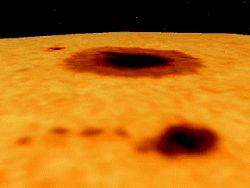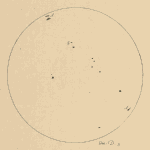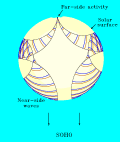 |
|
 |
|
The new research, gathered from the Michelson Doppler Imager (MDI) onboard the Solar and Heliospheric Observatory (SOHO), will deepen our understanding of stormy areas on the Sun -- called "active regions" -- where sunspots appear. Powerful explosions from magnetic active regions can trigger beautiful auroras on Earth and affect high-technology systems such as satellites, power grids, and radio communications. Above: Planet-sized dark spots on the Sun have puzzled scientists for hundreds of years. Click to view a 3 MB mpg movie.
"They obey what is a fundamental finding of observational science: Anything that does happen, can happen," said Philip Scherrer of Stanford University, Principal Investigator for SOHO's MDI. "We now have a hint at how [it happens]" Astronomers have long known that sunspots are regions where magnetic fields become concentrated. Yet anyone who played with magnets as a child has felt how magnetic fields of like polarities repel each other. Likewise, the strong magnetic fields of sunspots should naturally repel each other, causing the sunspot to quickly dissipate. Indeed, observations show that surface material clearly flows out of the spots.
Above: Long-lasting sunspots appear in this sequence of drawings made by Galileo himself as he observed the Sun from June 2nd to 26th, 1612. [more] Alexander Kosovichev and Junwei Zhao of Stanford University, along with Thomas Duvall of NASA's Goddard Space Flight Center, used MDI's unique ability to probe the happenings just below a sunspot's surface -- and for the first time they have clearly observed inward-flowing material. "We discovered that the outflowing material was just a surface feature," said Zhao. "If you can look a bit deeper, you find material rushing inward, like a planet-sized whirlpool or hurricane. This inflow pulls the magnetic fields together."
The intense magnetic field below a sunspot strangles the normal up-flow of energy from the hot solar interior. As a result a sunspot is cooler and therefore darker than its surroundings. The suppression of the bubbling convective motions forms a kind of plug that prevents some of the energy in the interior from reaching the surface. Below: An artist's concept of hidden gases swirling beneath a sunspot. Click here for images and movies from Stanford.
Since the magnetic plug prevents heat from reaching the solar surface, the regions beneath the plug should become hotter. A June 1998 observation provided evidence for this. "We were surprised at how shallow sunspots are," said Kosovichev. Below 3,000 miles (4800 km) the observed sound speed was higher, suggesting that the roots of the sunspots were hotter than their surroundings, just the opposite of conditions at the surface. "The cool part of a sunspot has the shape of a stack of two or three nickels," he added. "The cool downward flows dissipate at the same depth where the hot upward flows diverge," said Duvall. "With these data one cannot get a sharp enough picture to really explain the details. Until now we've looked down at the top of sunspots like we might look down at the leaves in treetops. For the first time we're able to observe the branches and trunk of the tree that give it structure. The roots of the tree are still a mystery."
SOHO continues to mark an era of successful partnership between the European Space Agency and NASA within the Solar Terrestrial Science program. |
 November 7, 2001: Using techniques similar to
medical ultrasound diagnostics, scientists have peered inside the Sun and
discovered what lies beneath sunspots, planet-sized dark areas on the
surface of our star. Sunspots are surprisingly shallow, say researchers,
and they lie on top of swirling hurricanes of electrified gas big enough
to swallow the planet Earth.
November 7, 2001: Using techniques similar to
medical ultrasound diagnostics, scientists have peered inside the Sun and
discovered what lies beneath sunspots, planet-sized dark areas on the
surface of our star. Sunspots are surprisingly shallow, say researchers,
and they lie on top of swirling hurricanes of electrified gas big enough
to swallow the planet Earth.
 What then makes sunspots so long-lasting? How do they
remain intact for weeks and months? A team of scientists had to look
beneath the surface of the Sun to find the answer.
What then makes sunspots so long-lasting? How do they
remain intact for weeks and months? A team of scientists had to look
beneath the surface of the Sun to find the answer.
 The material above the plug cools and becomes denser,
causing it to plunge downward as fast as 3,000 miles per hour (4800 km/hr)
, according to the new observations. That draws the surrounding plasma and
magnetic field inward toward the sunspot's center. The concentrated field
promotes further cooling, and as that cooling plasma sinks it draws in
still more plasma, thereby setting up a self-perpetuating cycle. As long
as the magnetic field remains strong, the cooling effect will maintain an
inflow that makes the structure stable. Outflows seen right at the surface
are confined to a very narrow layer.
The material above the plug cools and becomes denser,
causing it to plunge downward as fast as 3,000 miles per hour (4800 km/hr)
, according to the new observations. That draws the surrounding plasma and
magnetic field inward toward the sunspot's center. The concentrated field
promotes further cooling, and as that cooling plasma sinks it draws in
still more plasma, thereby setting up a self-perpetuating cycle. As long
as the magnetic field remains strong, the cooling effect will maintain an
inflow that makes the structure stable. Outflows seen right at the surface
are confined to a very narrow layer. Headlines
Headlines